If you ride your bike daily, I would recommend washing it at least once every weekend. You will be able to wash away the grime and dirt that it has accumulated over the week. On top of that, you can perform your own DIY maintenance, like lubing your chain.
First of all, I stay at an apartment, so I don't have my own garage and water hose. Here are the tools and products I use for a bike wash.
From left to right:
1. 2 pails, 1 for washing foam and 1 for clean water
2. Bottom section of a mineral water bottle, for splashing your bike with water
3. WD40, for lubing your key insertion points, and wiping dirt off your rims and sprockets
4. Autoglym Bodywork Shampoo Conditioner
5. Autoglym Aqua-Dry Chamois Synthetic Leather
6. PJ1 Blue Label Chain Lube
7. 2 washing mitts, 1 for bodywork and 1 for rims
8. 1 bag of cloths and sponges, for swapping out if any of the mitts become too dirty
You probably can't tell how much dirt there is on my bike, but trust it, it is dirty.
Start by removing parts that you don't want to get wet. For me, I remove these:
1. Front and rear brake reservoir socks
2. Headlight protectors
3. Rider seat
4. Passenger seat
Start by pouring a good amount of the washing shampoo into the pail. As a gauge, I make sure the bottom of the pail is covered with the shampoo before I start adding in water. Fill about half the pail with water, you don't need that much for the shampoo. Then fill the other pail with clean water.
If you have a hose, then use it to hose down the bike of dirt and dust. Use a softer setting for the water jet, you don't want it to damage any parts or scratch your paintwork. If you're like me and don't have a water hose, use a container like my mineral bottle to pour all over your bike. Be careful not to pour directly onto any electrical stuff like the battery.
The reason I use a water container and not a sponge to wet the bike is because you might leave scratch marks on your paintwork if it gets caught with hard particles. After that's done, it's time for the tedious part. I use one of the washing mitts for the plastics, and the other for dirty areas like the rims and sprockets.
Slowly clean from section to section. I like to start from the fuel tank, to the right fairing, left fairing, head cowl, tail, then exhaust. If you're not lazy like me, wash away the shampoo with clean water after shampooing those mentioned parts. Either by hosing it down with a water hose or a sponge. I wouldn't use the water container here because you might miss some areas. But I'm lazy haha, so I continue with my other washing mitt to wash the rims, sprockets, chain guard, and rear hugger.
I spend about 30-45 minutes for this entire process. Also use the time to inspect your bike. Who knows, you might find a missing nut or bolt. Or the worse, you find a new scratch. Oh well, it adds character to your bike haha.
The end result should look something like this.
Time to water the shampoo away. This time round, it's okay to use the sponge since you've washed away the dirt and grime. Make sure to wash all the shampoo away with clean water. If you miss any spots, it's going to leave a white spot later when it dries. Don't do that.
After this, I reassemble all the parts that I took out prior to washing. The chamois cloth now comes into play. I highly recommend you to buy one. Dampen the chamois cloth and rinse it as dry as your biceps allow, then wipe it over the wet areas of the bike. You will notice that there will still be water spots on the bike but they will be tiny and spread out, those water spots will evaporate perfectly and not leave water stains on your bike.
When I washed my bike this time, there were really stubborn (and sticky) stains on my rims and sprockets. So I used a random cloth and wet it with some WD40, then wipe away the stains. WD40 is a degreaser, so it makes your job fairly easy over those gooey parts. Be careful not to get any on your plastics though.
Time to lube the chain and WD40 all your key insertion points. Namely your ignition, fuel tank cap and passenger seat. Then viola, job done!
Remember to start your engine and rev it a few times to blow out water that might have went into your exhaust.
That's all for today. Ride safe!


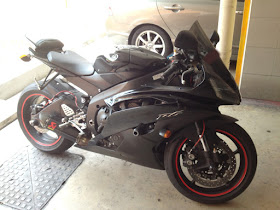
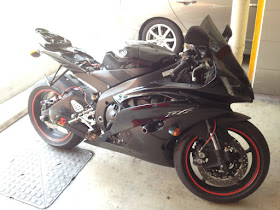
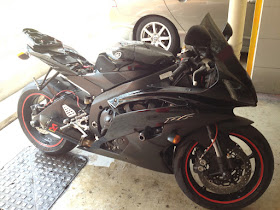
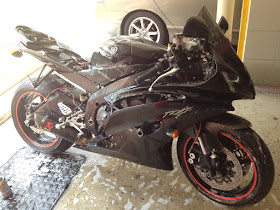
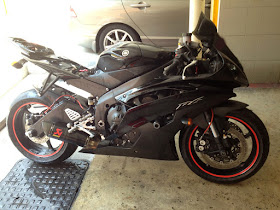
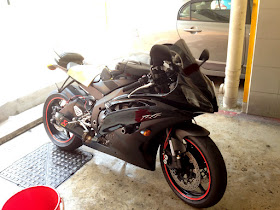

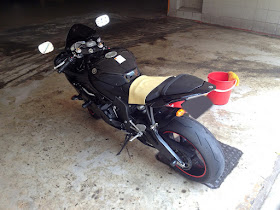
Washing of bike daily is best way to increase the performance of your bike as well as it help you to increase the life cycle of your bike.I also wash my bike twice a week.
ReplyDelete